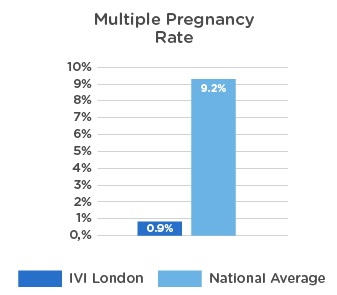

Our results make us leaders, but our real success is helping you build a family
Success rates can be calculated in lots of different ways, which can make the process of comparison between fertility clinics complicated. It is also difficult to know how accurately a clinic’s success rates really represent your individual chances of success.
The Human Fertilisation and Embryology Authority (HFEA) recommends using success rates as a guide, and not a prediction. Like any pregnancy, it is important to remember that every experience with fertility treatment is unique: the outcome depends on a number of factors that are individual to you and your personal circumstances.
If you are uncertain, it is always best to speak to one of our consultants. They can carefully review your medical history, suggest options, and discuss your personal chances of success. It is also an ideal time for your consultant to answer any questions you have in detail.
Below, you will find IVI London’s live birth rates for 2021, per embryo transferred, split by treatment type and age group. All statistics are compared to national averages for the same year, group of patients and type of treatment. If numbers of patients included in the statistics are less than 30, raw figures have been provided to avoid any ambiguity. If you have any questions about these results, please don’t hesitate to get in touch with us.
Live Birth Rate Per Embryo Transferred, All Treatment Types, All Ages
Live Birth Rate Per Embryo Transferred, IVF/ICSI, Frozen Cycles with Pre-Implantation Genetic Testing (PGT-A), All Ages
Live Birth Rate Per Embryo Transferred, IVF/ICSI, Frozen Cycles, Own Eggs with Pre-Implantation Genetic Testing (PGT-A) by Age Group
Live Birth Rate Per Embryo Transferred, IVF/ICSI, Frozen Cycles, Own Eggs, All Ages
(n=29)
Live Birth Rate Per Embryo Transferred, IVF/ICSI, Frozen Cycles, Own Eggs by Age Group
(<38 n=20)
(>38 n=9)
Live Birth Rate Per Embryo Transferred, IVF/ICSI, Fresh Cycles, All Ages
(n=22)
Live Birth Rate Per Embryo Transferred, IVF/ICSI, Fresh Cycles, Own Eggs by Age Group
(<38 n=12)
(>38 n=10)
Please note: Egg quality decreases with age which results in poorer outcomes during fresh IVF cycles. At IVI, we offer a number of treatment options for patients over 38 years of age, including PGT-A and egg donation which both improve chances of success.
Live Birth Rate Per Embryo Transferred, IVF/ICSI, Egg Donation Recipients, All Ages
(Fresh n=5)
(Frozen n=36)
For more information about our egg donation programmes, please contact us.

At IVI, we are committed to a strict Single Embryo Transfer (SET) approach. A multiple pregnancy is the biggest danger to babies conceived with IVF. Transferring multiple embryos during a single cycle significantly increases this risk. As a clinic, we are proud to provide the safest treatment for both mother and baby, reflected in our <1% multiple pregnancy rate. This rate is well below the UK national average and the target set out in the HFEA Code and Practice and Multiple Birth Strategy.
Live birth rate per embryo transferred is the measure of IVF success preferred by the HFEA. It refers to the rate of which a live birth occurs (either a single baby or twins) per individual embryo transferred during an embryo transfer procedure.
This is different to live birth rate per embryo transfer, which refers to the rate of which a live birth occurs (either a single baby or twins) per each embryo transfer procedure, during which multiple embryos may be transferred. While this can still be used an indicator of IVF success, patients should be aware that transferring multiple embryos during a single embryo transfer can put both mother and baby at risk. Read more about IVI’s Single Embryo Transfer policy.
You can find guidance on these metrics, and how to interpret them, published by the HFEA here.
You can also visit the IVI London HFEA clinic page where you can find a detailed breakdown of our verified clinical data, including our clinical pregnancy rates.